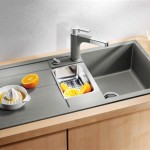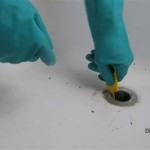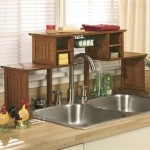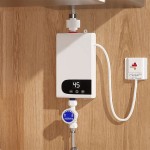Commercial Hand Wash Sink Faucet: A Comprehensive Guide
Commercial hand wash sink faucets are essential components of any establishment that prioritizes hygiene and sanitation. These faucets are specifically engineered for high-traffic environments, offering durability, functionality, and water efficiency. Selecting the appropriate commercial hand wash sink faucet requires careful consideration of factors ranging from material composition to activation mechanisms and compliance with regulatory standards.
The purpose of this article is to provide a comprehensive overview of commercial hand wash sink faucets, covering their various types, key features, selection criteria, maintenance requirements, and the importance of adhering to relevant codes and regulations. Understanding these aspects will empower facility managers, business owners, and plumbing professionals to make informed decisions regarding the selection and implementation of suitable hand wash solutions.
Types of Commercial Hand Wash Sink Faucets
The commercial faucet market offers a diverse range of options, each designed to cater to specific needs and preferences. Broadly, these faucets can be categorized based on their activation mechanism and design. Understanding these different types is crucial for choosing the optimal solution for a given application.
Manual Faucets: These are the traditional type of faucets, featuring handles that users must turn to control water flow and temperature. Manual faucets are generally less expensive than other types and require no electricity to operate. However, they may not be the most hygienic option in high-traffic areas, as users must physically touch the handle, potentially transferring germs. There are various styles of manual faucets, including lever handles, wrist blade handles (designed for ease of use with elbows), and cross handles. Lever handles are a popular choice due to their ease of use and ADA compliance when correctly installed. Wrist blade handles are often preferred in healthcare settings where minimizing hand contact is paramount.
Metering Faucets: These faucets dispense a pre-set amount of water with each activation. They are designed to conserve water by limiting the flow duration. Metering faucets are typically activated by pushing a button or lever. These faucets are suitable for applications where water conservation is a primary concern, such as public restrooms. However, the pre-set flow duration might not be sufficient for all users, and repeated activations may be required for thorough handwashing.
Touchless (Automatic) Faucets: Equipped with infrared sensors, touchless faucets activate automatically when hands are placed beneath the spout. This hands-free operation minimizes the spread of germs and promotes hygiene. Touchless faucets are increasingly popular in commercial settings, particularly in healthcare facilities, restaurants, and schools. Some models offer adjustable sensor ranges and automatic shut-off features to further enhance water conservation. They require a power source, either batteries or a hard-wired connection, and may be more expensive to install and maintain than manual faucets. The reliability of the sensor is critical, and regular maintenance, including cleaning the sensor lens, is necessary to ensure proper function.
Knee-Operated Faucets: These faucets are activated by pushing a panel with the knee, providing a completely hands-free operation. Knee-operated faucets are commonly used in surgical scrub sinks and other applications where maintaining strict hygiene standards is essential. They require installation at a specific height and may not be suitable for all users. While offering excellent hygiene, they may also require specialized plumbing adjustments.
Foot-Operated Faucets: Similar to knee-operated faucets, foot-operated faucets are activated by pressing a pedal with the foot. This type of faucet is also ideal for environments where hands-free operation is crucial, such as food processing plants and laboratories. Foot-operated faucets allow for precise water control and are often adjustable for temperature. Like knee-operated faucets, they require specialized plumbing and may not be universally accessible.
Key Features and Selection Criteria
Selecting the right commercial hand wash sink faucet involves considering several critical features and factors to ensure optimal performance, longevity, and compliance with regulations. These include material, flow rate, vandal resistance, compliance, and aesthetics.
Material: The material composition of a commercial hand wash sink faucet directly impacts its durability and resistance to corrosion. Common materials include brass, stainless steel, and chrome-plated brass. Brass is a durable and corrosion-resistant material, often used for the faucet body. Stainless steel offers excellent corrosion resistance and is a hygienic choice, particularly suitable for food service and healthcare environments. Chrome-plated brass provides an aesthetic appeal while retaining the durability of brass. However, the chrome plating can be susceptible to scratches and wear over time. Selecting a durable material is paramount to withstand the rigors of a high-traffic commercial environment.
Flow Rate: The flow rate of a faucet, measured in gallons per minute (GPM), determines the amount of water dispensed. Low-flow faucets are designed to conserve water and are often mandated by local regulations. Common flow rates for commercial hand wash sink faucets range from 0.5 GPM to 1.5 GPM. Selecting an appropriate flow rate involves balancing water conservation with the need for effective handwashing. Faucets with aerators can help to reduce water consumption without sacrificing water pressure. The flow rate should comply with local plumbing codes and regulations.
Vandal Resistance: In public restrooms and other high-traffic areas, vandalism is a concern. Vandal-resistant faucets are designed with robust construction and tamper-proof features to withstand abuse. These faucets may feature thicker metal castings, tamper-resistant screws, and enclosed components to prevent unauthorized access. Investing in vandal-resistant faucets can significantly reduce maintenance costs and extend the lifespan of the fixtures.
Compliance: Commercial hand wash sink faucets must comply with various codes and regulations, including the Americans with Disabilities Act (ADA), which mandates accessibility for individuals with disabilities. ADA-compliant faucets typically feature lever handles or touchless operation and require a specific reach range. Other relevant codes include plumbing codes that govern water efficiency and backflow prevention. Ensuring compliance with these regulations is essential to avoid penalties and ensure accessibility for all users.
Aesthetics: While functionality and compliance are paramount, the aesthetic appeal of commercial hand wash sink faucets also plays a role in creating a positive user experience. Faucets are available in a variety of styles and finishes to complement the overall design of the restroom or washroom. Consideration should be given to the architectural style of the building and the overall ambiance of the space. However, aesthetics should not compromise the functionality, durability, or compliance of the faucet.
Installation, Maintenance, and Regulatory Considerations
Proper installation, regular maintenance, and adherence to relevant codes and regulations are crucial for ensuring the optimal performance, longevity, and safety of commercial hand wash sink faucets.
Installation: Professional installation is essential to ensure that faucets are properly connected to the water supply, securely mounted, and compliant with local plumbing codes. Incorrect installation can lead to leaks, water damage, and reduced faucet lifespan. It is advisable to engage a licensed plumber with experience in commercial plumbing installations. The plumber should follow the manufacturer's instructions and ensure that all connections are tight and secure. Proper backflow prevention devices should be installed to prevent contamination of the water supply.
Maintenance: Regular maintenance is necessary to keep commercial hand wash sink faucets functioning properly. This includes cleaning the faucet exterior to remove dirt and grime, inspecting for leaks or damage, and replacing worn or damaged parts. For touchless faucets, cleaning the sensor lens is crucial to ensure proper operation. Mineral buildup can accumulate on faucet components over time, reducing water flow and causing malfunctions. Descaling faucets regularly can help to prevent these issues. A preventative maintenance schedule should be established to ensure that faucets are inspected and maintained on a regular basis.
Regulatory Considerations: Commercial hand wash sink faucets must comply with a variety of regulations, including the previously mentioned ADA guidelines and local plumbing codes. ADA compliance requires that faucets be easily accessible and operable by individuals with disabilities. Plumbing codes govern water efficiency, backflow prevention, and the use of lead-free materials. Some jurisdictions may have specific requirements for water conservation, such as mandating the use of low-flow faucets. It is essential to stay informed about relevant regulations and ensure that faucets are compliant to avoid penalties and ensure the safety and accessibility of the facilities.
The effective selection and maintenance of commercial hand wash sink faucets directly impacts the hygiene and functionality of commercial spaces. By understanding the various types available, focusing on key features and selection criteria, and adhering to regulatory guidelines, businesses can establish a cost-effective and hygienic hand washing solution.

Sauber Stainless Steel Wall Mount Hand Sink With Faucet 17 W

Regency 17 X 15 Wall Mounted Hand Sink With 8 Gooseneck Faucet And P Trap

Guardian G1101 Eyesafe X Faucet Mounted Eye Washes

Vevor Hand Sink With Faucet Nsf Stainless Steel For Washing Small Wall Mount Basin Utility

Regency 17 X 15 Wall Mounted Hand Sink With Waterloo Hands Free Sensor Faucet

Wellfor 17 In Wall Mount Stainless Steel 1 Compartment Hand Wash Sink With Faucet Tl Hwy 33853 The Home

Hand Wash Sink W Faucet Stainless Steel Wall Mount Kit Nsf 17 X 15

Kitchen Sink

Eagle Hwc T Space Saver Wall Mounted Hand Wash Sink With S Faucet

5f 4wwx03 4w Hand Sinks T S Brass







